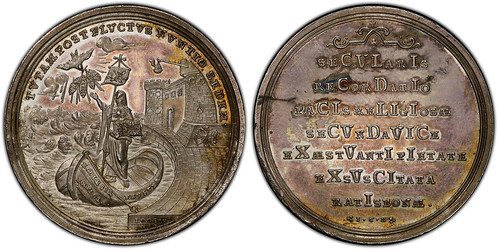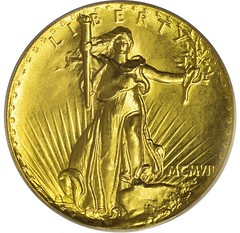
PREV ARTICLE
NEXT ARTICLE
FULL ISSUE
PREV FULL ISSUE
CHRONOGRAM QUIZ: 1755 AUGSBURG MEDALLast week I asked, "Oh, and who can spot the chronogram in this issue?" Dave Schenkman was the first to respond, correctly identifying the 1755 Augsburg medal in the Atlas Numismatics article. Bingo! -Editor
Augsburg Medal by Loos
1076053 | GERMAN STATES. Augsburg. 1755 AR Medal. PCGS SP63. By G. F. Loos. 14.69mm. 37.7gm. Allegorical figure of Religion steering a boat and holding open a book and flag with ChiRho; a dove of peace to left and city fortifications to right / Legend on seven-lines; date below. Whiting 506; Erlanger 2215; Plato 180. "My guess for the chronogram in this issue is the Roman numeral 1907 $20 St. Gauden's gold coin photo." Good guess because of the Roman numerals, but a chronogram is a little more involved. But first, a digression about the lightning-fast spread of AI-generated content online. Looking for a decent definition to reference, I found a page at Merriam-Webster.com. But instead of a clear, authoritative answer I found a bizarre, incomplete computer-generated page that perhaps I was the first human to actually set eyes on. A disclaimer reads "These examples are programmatically compiled from various online sources to illustrate current usage of the word 'chronogram.' Any opinions expressed in the examples do not represent those of Merriam-Webster or its editors." I appreciate the disclaimer, and understand what they're doing. And it probably does have some incremental value-add for the world, particularly in keeping up with rapidly-changing language and terminology from offbeat communities and specialties (such as numismatics, I guess). But not what I'd expect from a mainstream publisher. Software really is eating the world. Far, far, light-years better was the definition found on Wikipedia, the free encyclopedia. For all the pooh-poohing of the quality of the crowdsourced site in its earlier days, it has actually proven quite resilient and despite fears, is reasonably free of misinformation. The human-edited platform pretty effectively polices the zealots and nut cases, leading to content that most interested parties can, at least grudgingly, agree on. Here's an excerpt. -Editor
A chronogram is a sentence or inscription in which specific letters, interpreted as numerals (such as Roman numerals), stand for a particular date when rearranged. The word, meaning "time writing", derives from the Greek words chronos (χρόνος "time") and gramma (γράμμα, "letter"). In the pure chronogram, each word contains a numeral; the natural chronogram shows all numerals in the correct numerical order, e.g. AMORE MATVRITAS = MMVI = 2006.
To read the complete article, see:
Pete Smith writes: "I was working on the chronogram puzzle this week and was late for Monday coffee with my condominium group. The chronogram is on the German States Augsburg medal of 1755. There are seven lines on the reverse:
CVLI = 156
MDCCLV (shortened form) = 1755" Ken Spindler of San Diego writes: "This medal bears a chronogram - DDCCCCCCLLXXVVVVVIIIIIIIIII - not necessarily in that order, which adds up to 1,755. Year of medal 1755." Thanks, everyone! I would encourage a reader to contribute to Wikipedia a section on chronograms in numismatics. The most thorough treatment I recall is in volume one of one of my favorite numismatic books, Tempus In Nummis - The History and Fundamentals of Dating in Numismatics by James Sweeney and Robert Turfboer. -Editor
To read the earlier E-Sylum articles, see:
THE BOOK BAZARREBowers Series.It's a history-packed reference for both investors and collectors of the popular bullion series. Foreword by Q. David Bowers. 384 pages. Order your copy online at Whitman.com , or call 1-800-546-2995. Wayne Homren, Editor The Numismatic Bibliomania Society is a non-profit organization promoting numismatic literature. See our web site at coinbooks.org. To submit items for publication in The E-Sylum, write to the Editor at this address: whomren@gmail.com To subscribe go to: https://my.binhost.com/lists/listinfo/esylum All Rights Reserved. NBS Home Page Contact the NBS webmaster 
|

